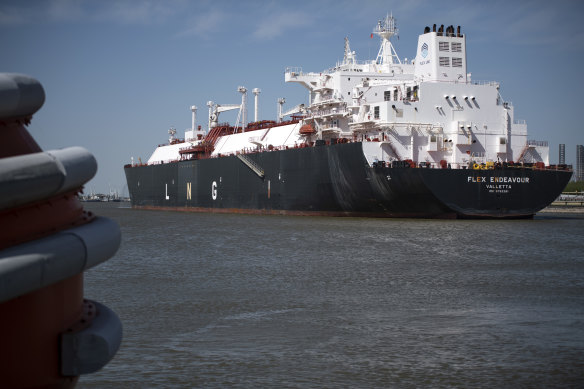
Tellurian has invested more than $US1 billion on the Driftwood development so far, but has struggled to sign up customers for its gas or find potential equity partners, which had raised concerns about its ability to finish building the terminal.
“A sell-down will be much easier now everyone knows Woodside is operating,” MST Marquee analyst Saul Kavonic said.

An LNG tanker waiting to be loaded in Louisiana. Woodside is hoping its purchase of Tellurian will give it exposure to the booming market.Credit: Bloomberg
Potential partners in the project could include US infrastructure players, Japanese energy buyers as well as Saudi Aramco and Abu Dhabi National oil company, he said.
Woodside’s bid to buy Tellurian and Driftwood comes amid an uncertain outlook for natural gas, a fossil fuel that’s widely used in heating, power and manufacturing but is also responsible for harmful greenhouse gas emissions that contribute to global warming.
LNG demand soared from 2022, as the end of COVID-19 lockdowns reignited the world’s energy needs just as the war in Ukraine was choking global supplies, causing a scramble for spare cargoes and sending prices for one-off deliveries soaring.
Now, the latest forecasts from investment analysts and the federal government suggest LNG shipments are on track for steep falls in the coming years, with warnings that the market risks flipping into oversupply after 2026 once vast new sources come online from the US and Qatar.
The prospect of Donald Trump winning the coming November election throws up even greater questions given he has vowed to unlock more supplies of oil and gas if he regains the presidency.
However, O’Neill said Woodside had “conviction” that the LNG market would continue growing significantly over the coming decade, pointing to base-case forecasts from Wood Mackenzie that demand could grow up to 50 per cent by 2033.
With Woodside’s strong balance sheet, customer book, capability and experience, the company was well-positioned to advance the Driftwood project, she added, while smaller developers would be weighed down by needing to secure long-term offtake agreements to underpin project financing.
“From a competitive perspective we know there are a number of companies that want to invest in US LNG,” O’Neill said. “When you look at the challenges, we bring advantages that many others don’t have.”
Loading
Woodside, one of Australia’s largest emitters, has come under intense scrutiny from environmental groups and its own investors for its pursuit of new oil and gas projects at a time of hastening global efforts to arrest climate change.
In a historic uprising earlier this year, 58 per cent of Woodside’s shareholders voted to reject its decarbonisation strategies, while many voiced concerns about the potential risks of expanding gas production.
As debate continues about the role of gas in the world’s transition to cleaner energy, Woodside and others in the industry insist LNG will remain an indispensable part of the global energy mix because it is less greenhouse-gas emitting than coal but can still be used as a back-up to renewable energy sources.
“That’s why we’ve got such conviction on LNG – it’s a flexible version of natural gas that can be transported around the world to where customers need it,” O’Neill said.
She welcomed the Albanese government’s “Future Gas Strategy”, released this year, which described gas as fundamental to the transition to net zero emissions and indicated that new production fields would receive stronger federal support.
The longer-term outlook for gas exports, however, may vary significantly depending on how aggressively countries decide to ratchet up ambitions to slash greenhouse gas emissions. Modelling from the International Energy Agency in 2021 found no new oil and gas fields could be developed for the world to achieve the Paris Agreement’s ultimate goal of limiting warming to 1.5 degrees.
The Business Briefing newsletter delivers major stories, exclusive coverage and expert opinion. Sign up to get it every weekday morning.









 Add Category
Add Category